You’re eager to experience Colorado’s majestic night skies. Knowing where to find the best stargazing spots is crucial for an unforgettable celestial journey.
However, light pollution and finding accessible locations can dampen your stargazing experience. You might miss out on Colorado’s most spectacular night views without proper guidance.
In this article, I guide you through Colorado’s dark sky havens. You’ll discover ideal spots for stargazing, learn about local conservation efforts, and find tips for optimizing your night sky adventure.
Key Things to Know:
- Colorado’s best dark sky sites include Black Canyon and Great Sand Dunes National Park.
- Local communities like Westcliffe and Silver Cliff actively reduce light pollution.
- Join star parties and astronomy clubs for enhanced stargazing experiences.
- Light pollution reduction and optimal viewing times are crucial for the best experience.
Understanding The Dark Sky Map Colorado and Stargazing Locations
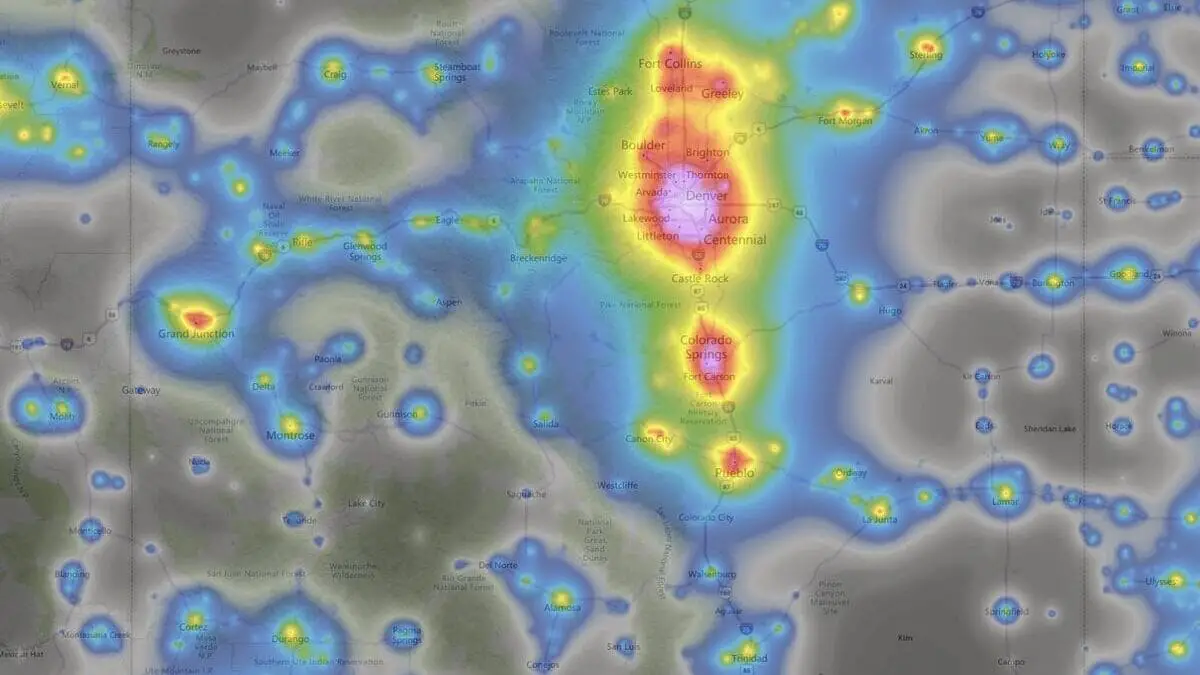
Knowing where to go is essential, as I’ve learned from my star-gazing adventures. Colorado offers some exceptional stargazing spots, free from city lights.
Essential Characteristics of Dark Sky Environments
Dark sky environments are unique. They let you see the stars without the glare of light pollution.
Here’s what makes these places great for stargazing:
- Darkness: I’ve witnessed how really dark skies, far from city lights, reveal the true beauty of the stars.
- Visibility: Clear views of the night sky and stars.
- Accessibility: Places you can reach for nighttime viewing.
Overview of Colorado Dark Sky Locations
Colorado is a stargazing haven with areas recognized by the International Dark-Sky Association (IDA). Look at the dark sky map to find these spots.
Here are a few:
- Black Canyon of the Gunnison National Park: Big, open skies.
- Great Sand Dunes National Park & Preserve: Dunes under a blanket of stars.
Check out these dark-sky places for a memorable stargazing trip, and remember to bring your map.
Top Dark Sky Parks and Designations in Colorado
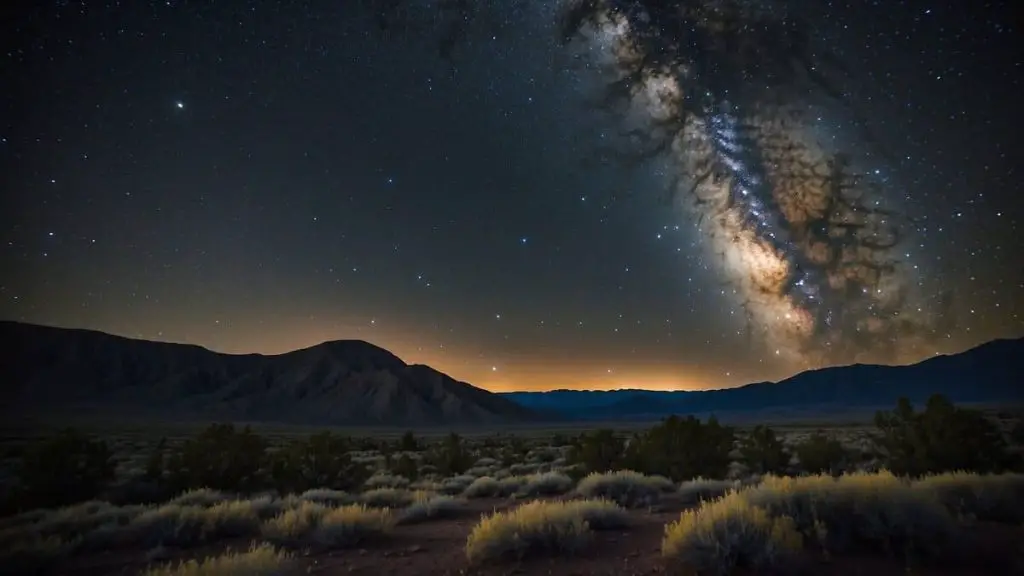
Colorado is a magnificent stargazing playground boasting several pristine Dark Sky Parks. These parks have earned special designations for their exceptional night sky quality and commitment to preserving darkness.
Black Canyon of the Gunnison National Park
At the Black Canyon of the Gunnison National Park, night skies are so dark you can gaze deep into the Milky Way. The park’s lack of nearby city lights means you’re in for a dazzling treat:
- Quiet and profound darkness
- Spectacular starry sights
Great Sand Dunes National Park and Preserve
Visit the Great Sand Dunes National Park and Preserve and marvel at the dunes set against a backdrop of stars:
- Natural sandbox under the stars
- Dark sky programs for all ages
Hovenweep National Monument
The stars at Hovenweep National Monument shine above ancient structures:
- Stargaze amidst historical sites
- A crystal-clear view of the constellations
Dinosaur National Monument
Discover a prehistoric landscape by day and by night at Dinosaur National Monument, with skies as untouched as the dinosaur fossils:
- A journey back in time under the night sky
- Celestial wonders above dinosaur bones
Remember, caring for our night sky helps keep these places magical for your visits and future generations.
For even more amazing stargazing in Colorado, check out my article.
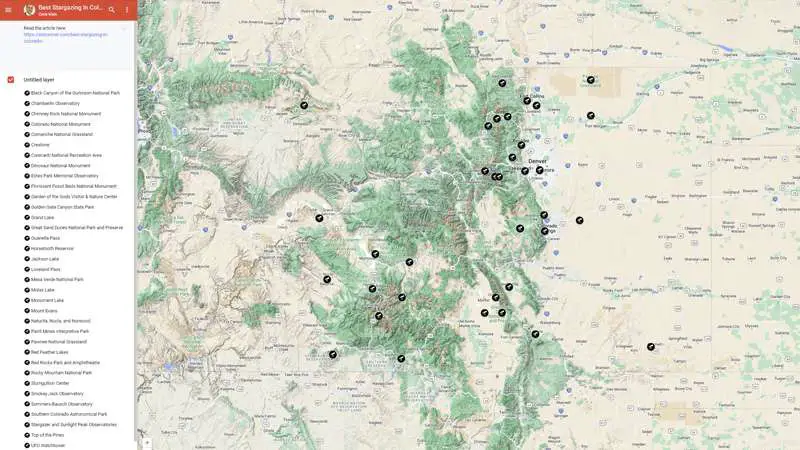
FREE STARGAZING CHECKLIST
My 5-page Stargazing Checklist will enhance your astronomical observations.
Follow this free checklist to navigate the night sky with confidence, clarity, and a sense of preparedness for a rewarding stargazing experience.

Emerging Dark Sky Communities and Conservation Efforts

Colorado is home to several communities that cherish the night sky.
These towns have made it their mission to reduce light pollution. You’ll find official dark sky communities and others aspiring to join them. Let’s look at some of these communities working hard to preserve the stars.
Westcliffe and Silver Cliff
Westcliffe and Silver Cliff are neighbors in the Wet Mountain Valley. They shine as Colorado’s first certified International Dark Sky Communities.
Here’s what you should know:
- They joined forces to curb light pollution.
- I’ve seen firsthand how these towns offer stunning views of the Milky Way, a sight not to be missed.
Ridgway Community Initiatives
On my visit to Ridgway, I admired how this scenic town is actively working towards becoming a Dark Sky Community. They aim to protect their night skies through community-led actions.
Ridgway’s residents are:
- Retrofitting lights to be night-sky friendly.
- Hosting dark sky events to raise awareness.
Norwood and the San Miguel Basin
In the San Miguel Basin, Norwood is also pursuing dark sky certification.
Their efforts include:
- Changing outdoor lighting to dark sky-approved fixtures.
- Educating locals on the importance of natural night environments.
Crestone in the San Luis Valley
Crestone, nestled in the San Luis Valley, has joined the push for dark sky status.
This small town is:
- Installing night-sky friendly lighting.
- Helping you see the stars without glare from the ground.
Remember, these communities need your help. Support their work by choosing dark sky-friendly fixtures and spreading the word. Your actions matter in keeping Colorado’s skies dark and filled with stars.
Stargazing Events and Astronomical Activities
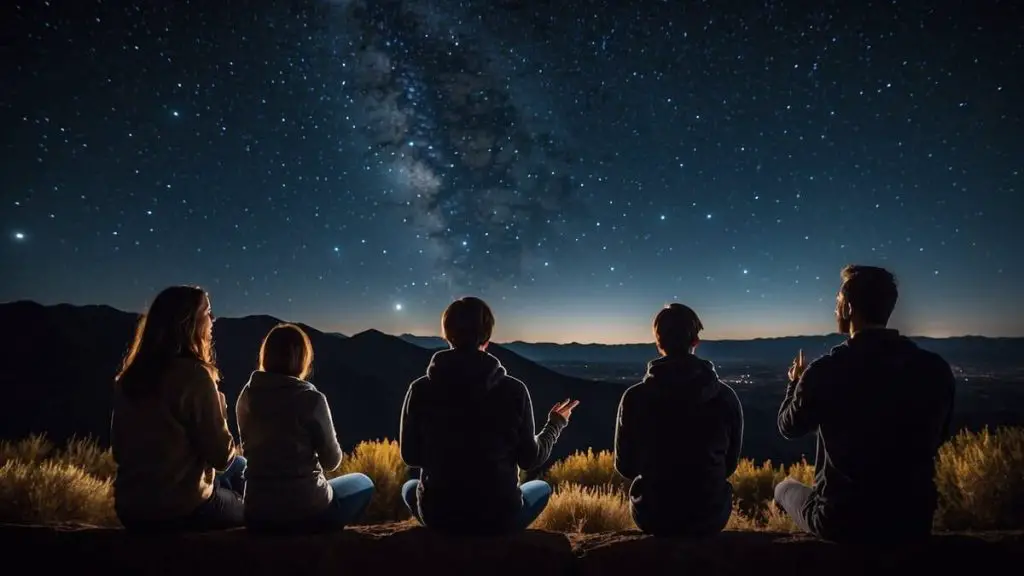
Colorado offers some fantastic sights for your eyes in the night sky. You can join star parties or learn from local astronomy clubs.
Star Parties and Celestial Events
- Star Parties: These are gatherings for anyone interested in the stars, and I’ve attended several that were truly enlightening. They’re held at dark-sky locations where the Milky Way stands out.
- Smokey Jack Observatory: You can view the stars through a powerful Celestron telescope.
- National Parks: Often host star parties where you can camp and watch the stars.
Astronomy Clubs and Societal Contributions
- Local Astronomy Clubs: Join clubs like the Black Canyon Astronomical Society to learn and observe.
- Youth Education: Places like the Slumgullion Center offer programs to get kids excited about astronomy.
Remember, you don’t need your own gear to start stargazing. Clubs often provide telescopes, like the popular Celestron, for public use.
Optimizing the Stargazing Experience in Colorado
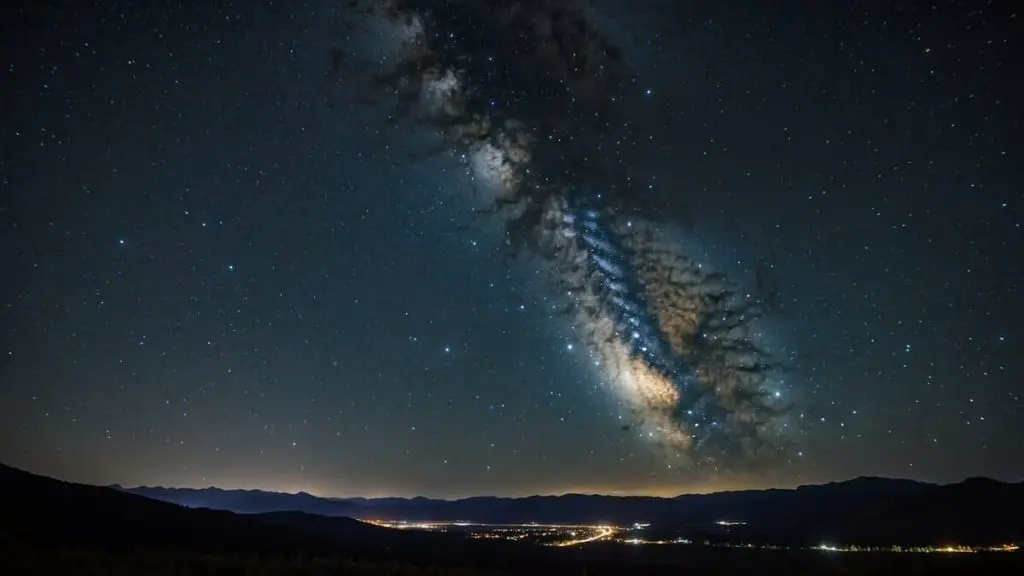
Stargazing in Colorado can be an amazing experience when prepped with the proper knowledge. From my experience, you’ll want to keep light pollution low and choose the best time to look up for the best views.
Best Practices for Low Light Pollution
Light pollution can spoil your stargazing fun. Here’s what you can do:
- Turn off outdoor lights around your home.
- Head to one of Colorado’s remote Dark Sky sites for the clearest views.
- Try using a red flashlight; it’s less harsh and sharpens your night vision.
Selecting Optimal Conditions for Viewing the Night Sky
The night sky changes, so picking the right time is critical.
- Aim for nights with low humidity; this means clearer skies.
- High elevation gives you an advantage; you’re above some of the atmosphere.
- New moons are best because the sky is darkest.
- Avoid nights with a full moon; it’s too bright.
- Lastly, check the weather to avoid a cloudy night.
Preserving Nighttime Ecosystems and Cultural Heritage
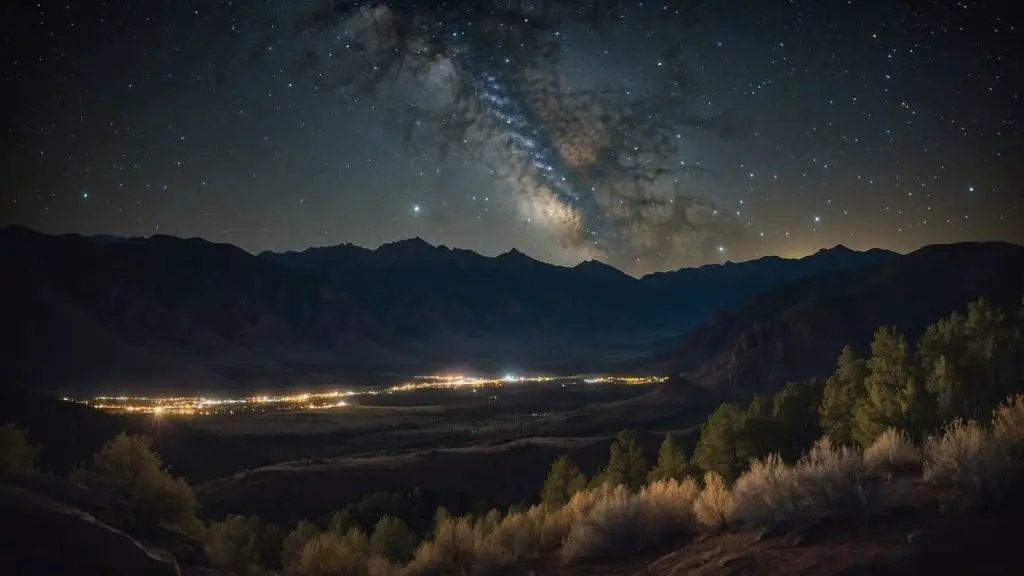
Colorado’s night skies are not just beautiful; they’re vital. They support wildlife and echo history.
Impact of Light Pollution on Wildlife and Ecosystems
Light pollution affects creatures big and small. Like Rocky Mountain National Park, which I’ve visited often, your favorite places have dark sky areas to help animals thrive.
Here’s why it matters:
- Wildlife: Animals rely on the dark. Too much light confuses them, especially nocturnal wildlife and migratory birds.
- Ecosystems: Plants and insects also depend on natural light cycles. A proper night-day rhythm lets them live and grow as they should.
Cultural and Historical Significance of Colorado’s Night Skies
Colorado’s skies tell stories and hold traditions. They’re a spiritual center for many, including the Navajo Nation. Key spots like Chimney Rock let you experience history under the stars.
Here’s what to know:
- Chimney Rock: This place is like a giant calendar made by ancient people. They used the stars there to tell time.
- Navajo Nation: For the Navajo, the night sky connects them to their culture. They see it as a spiritual map.
Remember the Florissant Fossil Beds National Monument? It’s not only about fossils. It’s a dark sky park, keeping the skies clear for everyone to enjoy and learn from.
Frequently Asked Questions
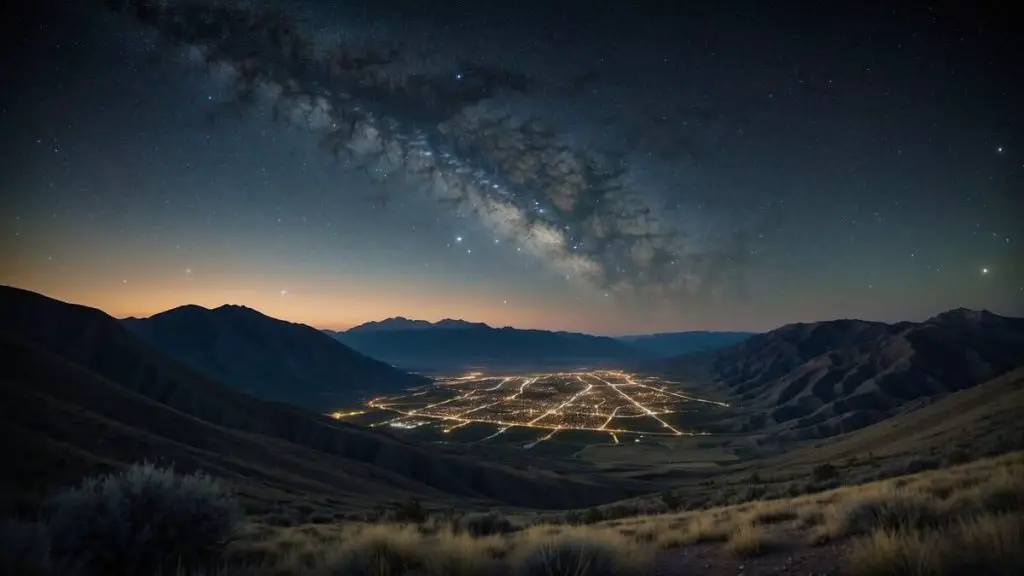
What are the Best Times of Year to Visit Colorado’s Dark Sky Parks?
The best times to visit Colorado’s dark sky parks are spring and autumn. During these periods, the skies are typically clearer, and the weather is more conducive for stargazing, enhancing your astronomical experience.
Can Beginners Easily Navigate the Dark Sky Maps in Colorado?
Yes, beginners can easily navigate the dark sky maps in Colorado. These maps are designed to be user-friendly, often featuring clear markings and guides on locating the best stargazing spots, making them accessible even for those new to astronomy.
Are There Specific Etiquette Rules to Follow When Visiting Dark Sky Areas?
When visiting dark sky areas, following specific etiquette rules is essential. This includes using red lights to preserve night vision, keeping noise to a minimum to respect wildlife and other stargazers, and ensuring that you leave no trace behind to protect these pristine environments.
TL;DR
- Colorado boasts numerous dark sky parks like Black Canyon and Great Sand Dunes, ideal for stargazing.
- Communities like Westcliffe and Silver Cliff are dedicated to reducing light pollution and enhancing night sky visibility.
- Engage in stargazing activities through local star parties and astronomy clubs, offering educational and observational opportunities.
- To optimize your stargazing experience, consider light pollution reduction strategies and select optimal viewing times.
- Colorado’s dark sky initiatives offer spectacular views and play a crucial role in preserving wildlife ecosystems and cultural heritage.
Your insights and questions are what make our stargazing community vibrant! Whether you’re curious about specific Colorado dark sky sites, need tips for your next night sky adventure, or have your own starry experiences, I’m here to chat.
Leave your thoughts and questions in the comments below – let’s keep the conversation sparkling!




